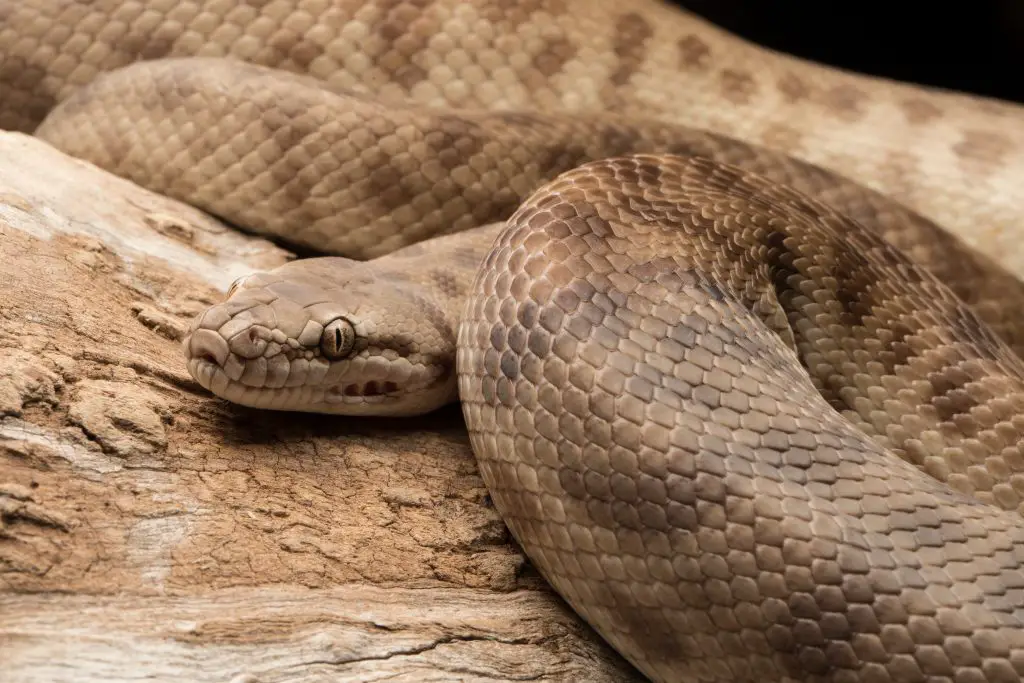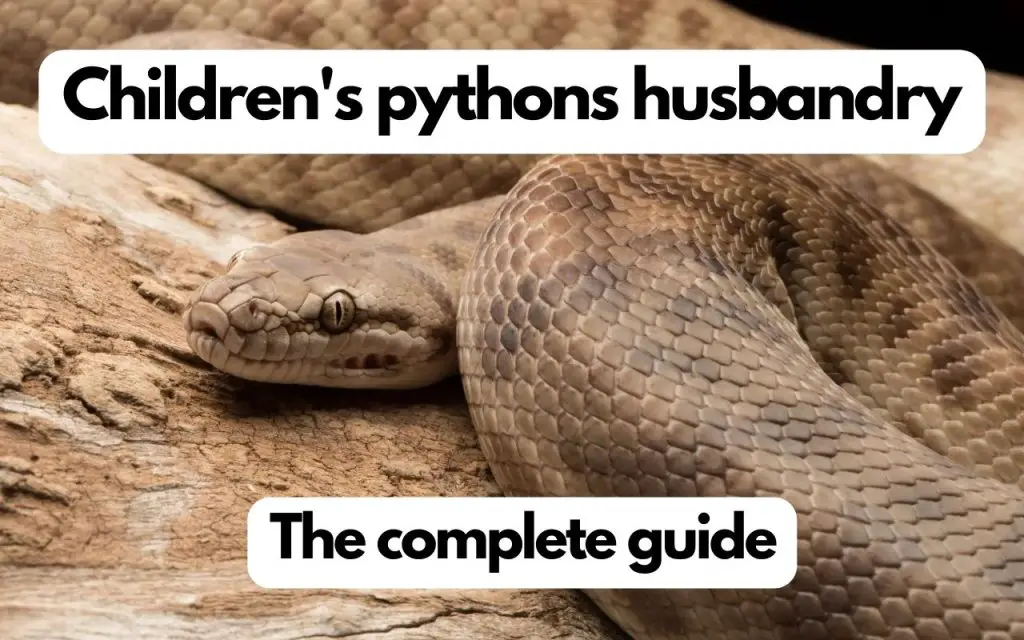Hello, fellow reptile lovers! If you’re reading this, it’s safe to say you share my passion for snakes, and pythons in particular. Having kept a variety of reptiles over the years, I’ve gained a wealth of hands-on experience that I’m excited to share with you. Today’s topic is one of the most underrated species in the hobby – the Children’s Python, or Anteresia childreni.
For those unfamiliar, the Children’s Python is a small, relatively docile snake native to northern and central Australia, and it’s an absolute joy to keep. I remember when I first got my first Children’s Python, Monty. Monty immediately stood out with his calm demeanor, and was an extraordinary pet. But, what does caring for a Children’s Python like Monty entail? Let’s find out…
Creating the Perfect Habitat
Setting up an enclosure that mirrors a Children’s Python’s natural habitat is essential for their health and happiness. It’s like setting up a little slice of Australia right in your living room. Here’s a detailed guide to help you create the ideal setup:
1. Enclosure Size
An adult Children’s Python doesn’t need an overly large enclosure—a 20-gallon tank is generally sufficient. Generall speaking, most adults only reach 3ft in length at most. Nonetheless, while these snakes aren’t as active as some other species, they still enjoy the freedom to move around and explore. You can use other types of enclosure too, so long as you make sure they are at least 2ft (60cm) long.
2. Substrate
A good substrate is key. Personally, I’ve had the best luck with newspaper and paper towel as they are easy to clean and replace. If you want to level up the aesthetics of the enclosure, cypress mulch or aspen shavings are great options. But, avoid using substrates like sand and cedar shavings—they can cause more harm than good.
3. Hide Boxes
Children’s Pythons are masters of hide-and-seek. They enjoy privacy and need at least two hide boxes—one in the warm area and another in the cool. Over the years, I’ve noticed Monty’s preference for switching between the two boxes depending on his mood.
4. Climbing Branches
While they’re primarily terrestrial, these curious creatures enjoy an occasional climb. I’ve added sturdy branches and reptile hammocks in Monty’s tank, and he’s often found lounging on them, observing his surroundings.
5. Water Dish
This is an absolute necessity. A water dish large enough for your python to soak in but shallow enough to prevent any risk of drowning is ideal.
6. Temperature Gradient
Just as the weather changes throughout the day in the wild, the temperature inside the tank should vary from one end to the other. It’s important to keep a gradient from 28-30°C (82-86°F) at the warm end to 23-25°C (73-77°F) at the cooler end.
When it comes to heating appliances, the best option for a glass tank or plastic tub is an under tank heat mat. This should be placed under the enclosure, and used with an on/off or pulse-proportional thermostat. The thermostat probe should be placed between the mat and the outside of the enclosure.
For a vivarium, the best option is a ceramic heat emitter, which must be housed inside a safety guard and used in conjunction with a pulse-proportional thermostat.
Always double check temperatures with an infrared thermometer gun – don’t just rely on the thermostat.
7. Humidity
Children’s Pythons are comfortable at 50-60% humidity. However, during shedding periods, I’ve found that slightly increasing the humidity can help them shed more comfortably. Monty’s shedding improved noticeably once I started following this practice.
Feeding Your Children’s Python
Feeding times are often the most exciting for both the pet and the pet owner. Children’s Pythons are carnivorous, and watching them eat can be quite an experience. I still remember the first time I fed Monty—it was fascinating to see his instincts kick in.
Here’s a detailed breakdown of feeding guidelines by age:
| Age | Food | Feeding Frequency |
|---|---|---|
| Hatchling to 1 year | Pinky Mice | Every 5-7 days |
| 1 to 3 years | Fuzzies to Hoppers | Every 7-10 days |
| 3+ years (Adult) | Adult Mice | Every 10-14 days |
Remember, the size of the rodent you feed your python should not be larger than the widest part of your python’s body. I made the mistake of offering Monty a meal that was too large once, and it ended up being more stressful for both of us.

Keeping Your Python Healthy
Caring for a Children’s Python involves regular health check-ups. Look for clear eyes (except during shedding), healthy skin, a strong appetite, and regular bowel movements.
Common health issues include:
- Mites and Ticks: Regularly inspect your python and its enclosure for any sign of these pests.
- Respiratory Infections: Wheezing, drooling, or loss of appetite can be a sign of a respiratory infection.
- Mouth Rot: If you see any discoloration or pus around the mouth, it may indicate mouth rot.
- Scale Rot: This is often caused by excess humidity. It’s essential to maintain a proper moisture level in the enclosure.
As with any reptile, bear in mind that hygiene, humidity, diet, and temperature are the key components of health. Get these right, and your snake probably won’t ever get sick. As I always say, prevention through good husbandry is the best kind of health care.
Handling and Socializing Your Children’s Python
When it comes to handling, Children’s Pythons are one of the easiest snakes to deal with. They’re generally docile, and their small size makes them manageable. Also, if we’re realistic, they just aren’t big enough to do any damage even if they did bite.
Note: they aren’t called Children’s Pythons because they’re for kids, although they are a great first snake. They got the name because the species was described by John George Children, a 19th century naturalist.
Here are some tips for handling:
- Always support their body while handling.
- Be gentle; avoid fast or sudden movements.
- Handle them regularly to keep them socialized, but limit handling during shedding.
Conclusion
Through this post, I hope I’ve been able to give you a glimpse into the fascinating world of Children’s Python care. Remember, each snake is different, and what works for Monty may not work for your python. Stay observant, flexible, and most importantly, enjoy the journey!
In truth, the Children’s Python is one of the best pet pythons available today. It just gets overlooked because of its smaller size and more subtle markings compared with many other species.
My feeling is that in time, more and more morphs (color variations) of these snakes will become available in the US and Europe. Eventually, it will be one of the most popular pet snakes. Why not get some experience with them now?

FAQ related to Children’s Python Care
Do children’s pythons like to be held?
It’s extremely difficult to determine whether any snake really likes to be held. They don’t show complex emotions like we do, after all. What is certain is that Children’s Pythons are very docile, and adjust well to regular, gentle handling. To me, it does seem like some of them enjoy being handled because they use it as an opportunity to climb and explore.
How big should a children’s python enclosure be?
The ideal Children’s Python enclosure should be at least 24in (60cm) long, by 12 (30cm) high and 18in (45cm) deep. Though they are a very small species, many of them are still reasonably active. Their enclosure should give them opportunities to explore and climb. It should also be larger enough to support a thermal gradient (warm side and cool side)
What is the best bedding for a children’s python?
Personally I think newspaper is the cheapest, easiest, and most hygienic. You can even get unprinted newspaper offcuts on Amazon or eBay. That said, it’s not exactly what I’d call aesthetically pleasing. If you go to the trouble of making a naturalistic enclosure, you’ll be better off using something like cypress mulch.

